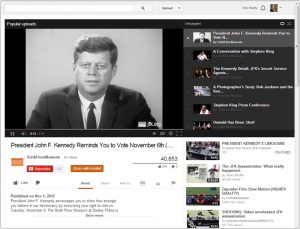 Over 4 billion hours of video are watched every month on YouTube. Over 4 billion hours….a month! Clearly, video is compelling to a lot of people.
Over 4 billion hours of video are watched every month on YouTube. Over 4 billion hours….a month! Clearly, video is compelling to a lot of people.
Recently The Sixth Floor Museum at Dealey Plaza launched a new YouTube page in recognition of the fact that YouTube has become one of the world’s most popular Internet search engines. We’re still new at this but our first uploads have generated exciting results. Our very first upload was an October 1962 PSA created by President John F. Kennedy which encouraged all Americans to “vote next Tuesday, November 6th.” The timing of our release was terrific because last year’s presidential election actually took place on Tuesday, November 6 and everyone was curious to hear what President Kennedy had to say about the “upcoming” election. The upload has received almost 40,000 views. Check it out if you’re curious.
In addition to the PSA we have also uploaded videos from our public program archive and productions created for temporary exhibits. As we delve deeper into the world of YouTube, I’m pretty sure that there’s an educational and interpretive opportunity beyond simply sharing our content.
I’d welcome your input and hope to start a conversation:
- Are you using YouTube—or other video sharing sites such as Break, Metacafe, Vimeo or Dailymotion—in creative ways, and if so, what are you doing?
- How are you using video to engage students, teachers, youth adults or other specific audiences? Anyone using video sharing sites for contests, program overviews or behind-the-scenes tours?
- What lessons have you learned that might be useful to your colleagues?
- Have you come across any copyright or permission pitfalls that can be avoided?
- How do you handle negative or inappropriate comments?
- Which state and local history site posts your favorite video content?
Looking forward to hearing how history institutions are showcasing video content, so please, broadcast yourself and share how you’re making the most of our fascination with video!



